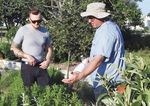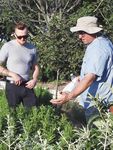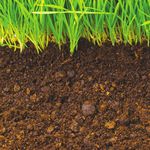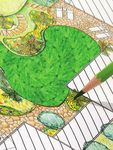The edible landscape foodscaping: Water University
←
→
Page content transcription
If your browser does not render page correctly, please read the page content below
The Edible Landscape
E
dible landscapes put us back in touch with the land we
live on, the people around us, and the food we eat.
Maybe you’re interested in incorporating edible plants
into your existing landscape or planning on designing a new
section of your yard for both beauty and function. By utilizing the
most effective water efficient methods, you can work within your
city’s watering guidelines and grow some of your own food. No
matter who you are, there is a style of edible gardening to meet
your needs, suit your taste, and capture your imagination.
A Shift in Perception
While it was once common practice to maintain a yard consisting
primarily of turfgrass (managed to be both labor and resource
intensive), many people are opting to transition a portion of their
landscape into vegetable, fruit, or nut production. The latest
studies report that as many as 35% of American households
are now growing at least some of their own food - the largest
numbers in more than a decade. Why mow it, when you can
grow it?
Planning and Design
Just like any other addition to
your property, it is important
to put some thought into the
design of your edible garden
or landscape in order to
give you the best chance for
success. Plant your food with
an eye for the overall beauty
of the landscape in mind.
Defining Style
Naturalistic - meandering lines
flow organically through the
landscape, reminiscent of the
lines one might see in nature.
Structured - clean,
precisely manicured lines
divide landscape sections Location: Right Plant, handle growing in areas strictly ornamental plants.
geometrically, giving the Right Place shaded by your home, fence, Others do quite well with
space an arcitectural Select the best possible or existing plants in the minimal irrigation. Whatever
sensibility. location for each plant taking landscape? you’re growing, it is
into account these factors: important that available
Choose a design to Water water resources are used as
complement or contrast the Size Plant the water first! Whether efficiently as possible.
style of your house to make Be mindful of the mature you’re growing a few veggies
your garden welcoming and height and width of your in pots, or incorporating Drip irrigation or multi-
interesting to the eye. edible plant material, edible berries, shrubs, or stream rotors are great
allowing room to grow and trees into your landscape, it technologies for reducing
Consider proper spacing for airflow. is important to think about water lost to evaporation,
• Structure water before you place any and can be retrofitted to an
• Movement Light plants or seeds in the ground. existing irrigation system.
• Layering heights Do the fruits, vegetables, Some edible plants might Soaker hoses and/or hand
• Color contrast or herbs you want to grow require a little more water watering work great, too, for
• Evergreens require full sun, or can they than our native and adapted, Continued
1Continued from page 1
certain situations. Whatever
the watering plan is for your
edible landscape project, be
sure to pair it with a ½”
topdressing of quality compost
and 2”- 4” of mulch to increase Soil kit online
the effectiveness of the water
in the root zone! Soiltesting.tamu.edu is your
one-stop shop for everything
Soil you need to get your soil
Proper soil preparation and sample submitted to Texas
maintenance is key to a A&M AgriLife scientists for
successful edible landscape, testing.
especially considering the
challenges of the heavy
clay, alkaline soils commonly
seen in parts of Texas. We
recommend starting out with a
simple and inexpensive soil
test from http://soiltesting.
tamu.edu. Not only will it help Web Resources
you decide which fertilizers you
might need to add and in what
amounts, but it might also
prevent you from adding too
Visit tinyurl.com/
much fertilizer or nutrients you
aggievegselector to help
don’t need, saving you money
you figure out which
and preventing runoff into
vegetables work best in
nearby bodies of water.
your garden.
What to Grow
It’s always best to focus on Getting Started
what you or your friends and Pre-Existing Bed
family like to eat. You might • Remove undesirable,
even be able to save a little struggling, or high
money and reduce your maintenance
grocery bill. Other people like plants
to experiment with edible • Replace with
plants that serve multiple well-adapted
purposes. Many plants are edibles
both edible and highly
ornamental with varying Starting from
colors and textures of foliage, Scratch
showy fruits, and different • Remove
bloom times for year-round existing
appeal. vegetation
• Add soil
Consider amendments
• Edible flowers • Install Irrigation
• Edible tree crops • Install
• Edible shrubs hardscape
• Herbaceous fruits and • Plant
vegetables • Mulch
• Herbs
2Edible Plants for North Texas Landscapes
Showy Annual Vegetables Shrubs Herbs
Vegetables are usually characterized Just like their ornamental counterparts, Many culinary herbs provide ornamental
into two groups: cool season and edible bushes and shrubs should be value, as well. Perennial herbs, like
warm season. Try utilizing cool season planted in spring or fall. It is a good rule rosemary, oregano, and mint, are
cabbages, kales, lettuces, or other of thumb to avoid planting during the evergreen to semi-evergreen, while
showy greens as cool season borders heat and water stresses of summer. basil, cilantro, and dill can easily reseed.
in the landscape. Warm season fruiting • Bay Laurel • Basil
vegetables like tomatoes, peppers, and • Blackberries • Cilantro
eggplant can be showcased for their • Clove currants • Culinary Sage
bright colored fruits when temperatures • Elderberry • Dill
warm up. Vining vegetables add both • Goji berries • Mint
vertical height and textural interest along • Nanking Cherry • Oregano
with color. Refer to seed packets and • Silverberry • Pineapple Sage
plant tags for specific planting dates, • Rosemary
or go to the Aggie Horticulture Planting • Thyme
Guide: tinyurl.com/aggieplantingguide. Tree Crops • Mexican Tarragon
• Beans Container grown trees are best planted
• Beets in fall going into dormancy. Bare root
trees are best purchased and planted Edible Flowers
• Cabbage
before March or before the buds start to For those wishing to expand their edible
• Eggplant
swell. Although edible tree crops can be palate, some flowers have delicious
• Kale
planted at other times, it is best to avoid and interesting flavors. Consider, for
• Lettuce
planting in the heat of the Texas summer. example, the cucumber-like borage or
• Peppers
• Apples spicy pepper-like nasturtiums.Not all
• Sweet Potato
• Asian Pear flowers are edible, so make sure that it is
• Swiss Chard
• Figs before tasting it.
• Tomatoes
• Jujubes • Borage
• Okra
• Mulberry • Cornflower
• Peaches • Daylily
Perennial Vegetables • Pecans, Walnuts • Dianthus
Once perennials are planted, they come • Persimmons • Lavender
back year after year, making the best use • Plums • Nasturtiums
of natural resources. These vegetables • Pomegranates • Squash
are not only beautiful and tasty, but also • Viola spp.
require very little supplemental irrigation.
• Artichoke Citrus (protect from frost) Always refer to the botanical name when
• Asparagus • Kumquat (‘Marumi’, ‘Meiwa’) verifying whether a plant is safe to eat.
• Radicchio • Satsuma (‘Orange frost’, ‘Artic frost’)
• Sorrel • Loquats
• Sunchokes (Jerusalem artichokes)
• Walking Onions, Garlic, Chives
This publication cannot be reproduced wthout written consent
from Texas A&M AgriLife Water University.
By Daniel Cunningham, Patrick Dickinson,
Dotty Woodson and Clint Wolfe
17360 Coit Rd., Dallas, TX 75252
wateruniversity.tamu.edu Illustrations and design by Gabe Saldana
3You can also read


























































